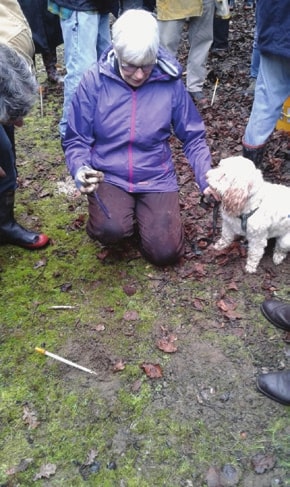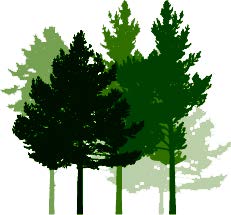Truffles and the compulsory acquisition of forest land
Hamish Levack, New Zealand Tree Grower May 2021.
Alexander Georgiev, a Bangor University primatologist, collected samples of some truffles after he observed a group of wild bonobos eating them in the Congo’s Kokolopori Reserve. Since last September, this species has been classified as Hysterangium bonobo. We still have much to learn about all truffle species, not only H. bonobo.
Truffles are smelly bags of spores, designed to be eaten. They have a transformative effect on food and grow in association with trees. Ordinary fungi push their caps above ground and shed spores into the wind, but truffles rely on persuading animals to carry spores around in their stomachs, to be dispersed around the forest in dung. As the fruit bodies grow and ripen, they synthesise aroma chemicals which spread out in the soil and eventually reach the air. Long before a passing human nose would detect anything, other animals, including our near relatives the bonobos, can track them down.
The trufière
Truffles are unpredictable and unseen while they develop, and are therefore difficult to grow. Truffle crops are still very experimental. Three species have been produced commercially in New Zealand − Périgord black truffle, Burgundy truffle and Bianchetto, but many efforts to establish truières have failed. Those which do succeed, take four to 12 years to become productive.
Arthur and Linda Cooper, who live near Levin, were successful. They established a truière with English oak and hazelnut trees, inoculated with Périgord black truffle mycelium. They have been producing top grade, export quality Périgord black truffles over the last seven years, with the best quality truffles fetching up to $3,500 a kilogram.
In July 2020, the NZFFA Wellington and Central Districts branches had the privilege of visiting the Coopers and accompanying them and their trained dog, Pippa, on a truffle hunt. Pippa was delighted every time she discovered a truffle, and although we did not have tails to wag, so were we.
The compulsory acquisition of the trufière
The Coopers were shocked when the government told them it needed their four-hectare lifestyle block, including the truière, to develop the expressway north of Levin. Under the Public Works Act 1981 and amendments, the Minister of Lands has the power to ‘acquire any land, building, or structure required for any government work, to settle the associated purchase price or compensation, and to administer, develop, improve, transfer, or dispose of any such property’. Consequently, individual forest areas have often been taken or reduced by land acquisition, such as for the establishment of public roads, railway lines or electricity transmission corridors.
These powers are likely to be extended as a result of the recommendations of the Resource Management Act review. The report said that the Act should be repealed and replaced by new laws, one being the Natural and Built Environment Act and another being the Strategic Planning Act. These proposals are supported in principle by National and Labour and the process for change is already under way.
Some lifestyle blocks vulnerable
Such a revision may provide positive results for the forest sector. The Resource Management Act is now twice the size it was three decades ago and, as well as failing to protect the natural environment properly, it has dissuaded the construction of new, or sometimes even the expansion of existing timber mills. However, the review has not really been due to the latter concern, but rather to the need to make it easier to secure land on which to construct much-needed ‘affordable housing’. This requirement has been foreshadowed by the Urban Development Bill which makes farm forestry members with lifestyle blocks near urban areas particularly vulnerable to having their properties taken by compulsion.
Most readers will not consider mandatory acquisition for the greater good of the community unreasonable, provided those affected are adequately compensated. However, this article gives an example where the owner of a small forest owner was pillaged by the government, via the Land Transport Authority, and outlines how to argue for a better deal if you find yourself in the same boat.

Valuing the forest and trufière
Apart from their substantial house, garden and truière, Arthur and Linda Cooper also owned a small forest consisting of redwood, Japanese cedar and Tasmanian blackwood on their lifestyle block just north of Levin. They were preparing to retire, which would have meant selling up and moving into a smaller property, but in January 2018 this plan was stalled by them being advised that their lifestyle block would be needed for the 300-metre wide expressway being extended north of Levin.
Then in December 2018 the Land Transport Authority reversed the acquisition order, saying that it was unsure when any land for that section of the expressway would be needed in the foreseeable future. After the Coopers had engaged Hugh Rennie QC to argue on their behalf, the Land Transport Authority accepted that the circumstances were such that the Coopers would now be unable to sell their land to anyone but the government. The question was then one of fair compensation. Because ample recent sales data was available, a reasonable value for the house and garden was fairly quickly agreed, but the negotiating agent The Property Group, resisted a reasonable determination of value for the small forest and the truière.
The Property Group engaged a ‘forestry expert’ who said the trees in the Cooper’s small forest were far too young at 20 years to have any timber value. The Property Group also commissioned an expert orchard valuer who said that the truière was only worth $89,750, considerably less than the cost of setting it up. The Coopers, who were both nearly 80 years old, reluctantly accepted the government’s compensation offer, but if they had the time, energy and bountiful financial resources they could have mounted a challenge in court that may well have resulted in them getting much more compensation.
Value on the basis of expected income
The ‘expert’ valued the stand if it was to be liquidated immediately, which means that no account has been taken of the increases in value brought about by future tree growth or an investor’s time preference for funds. However, forest sales in New Zealand are usually based on the New Zealand Institute of Forestry Professional Handbook recommendation that stands should be valued on the basis of expected nett income. In other words, cashflows relating to future income and costs are estimated, and then discounted to give current stand value. Conservatively this would have meant that the Coopers small forest was worth $7,475.
As a component of a well-planted lifestyle block, the stand is likely to be worth much more than $7,475 today. There are estimates in the literature that such trees may raise the property value by as much as 15 per cent, because of their amenity, biodiversity, recreation, shading, noise insulation, fuel wood, spiritual and other values.
The expectation value of the trufière
The argument that the expectation method should be used to value a forest stand applies equally to the Cooper’s truière, which after all is just a special sort of woodlot. Dr Nicholas Malajczuk, an internationally-recognised truffle guru, provided the Coopers with an opinion that their truière could easily produce 100 kilograms a year of black truffles worth $3,000 a kilogram. The discounted cash low of this income over 20 years amounts to more than $4 million. The oak trees will also be worth a significant amount.
All this does not have regard for the future management and harvest costs of the truière, but they would be far smaller than the income. Therefore, beware if the government or your local authority wants to compulsorily acquire your land and how they have valued the compensation that they are offering you.
Hamish Levack is the immediate past president of the NZFFA.

 Farm Forestry New Zealand
Farm Forestry New Zealand